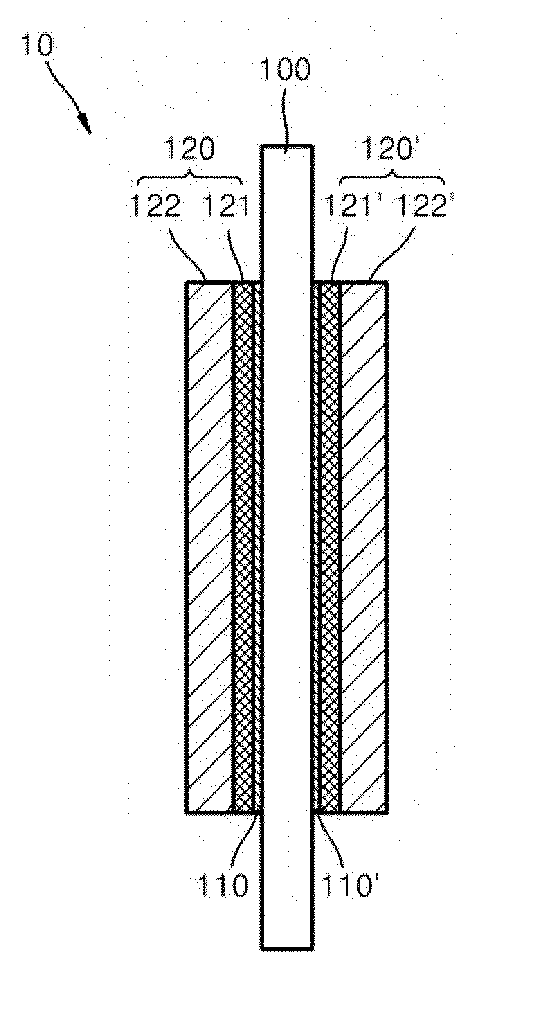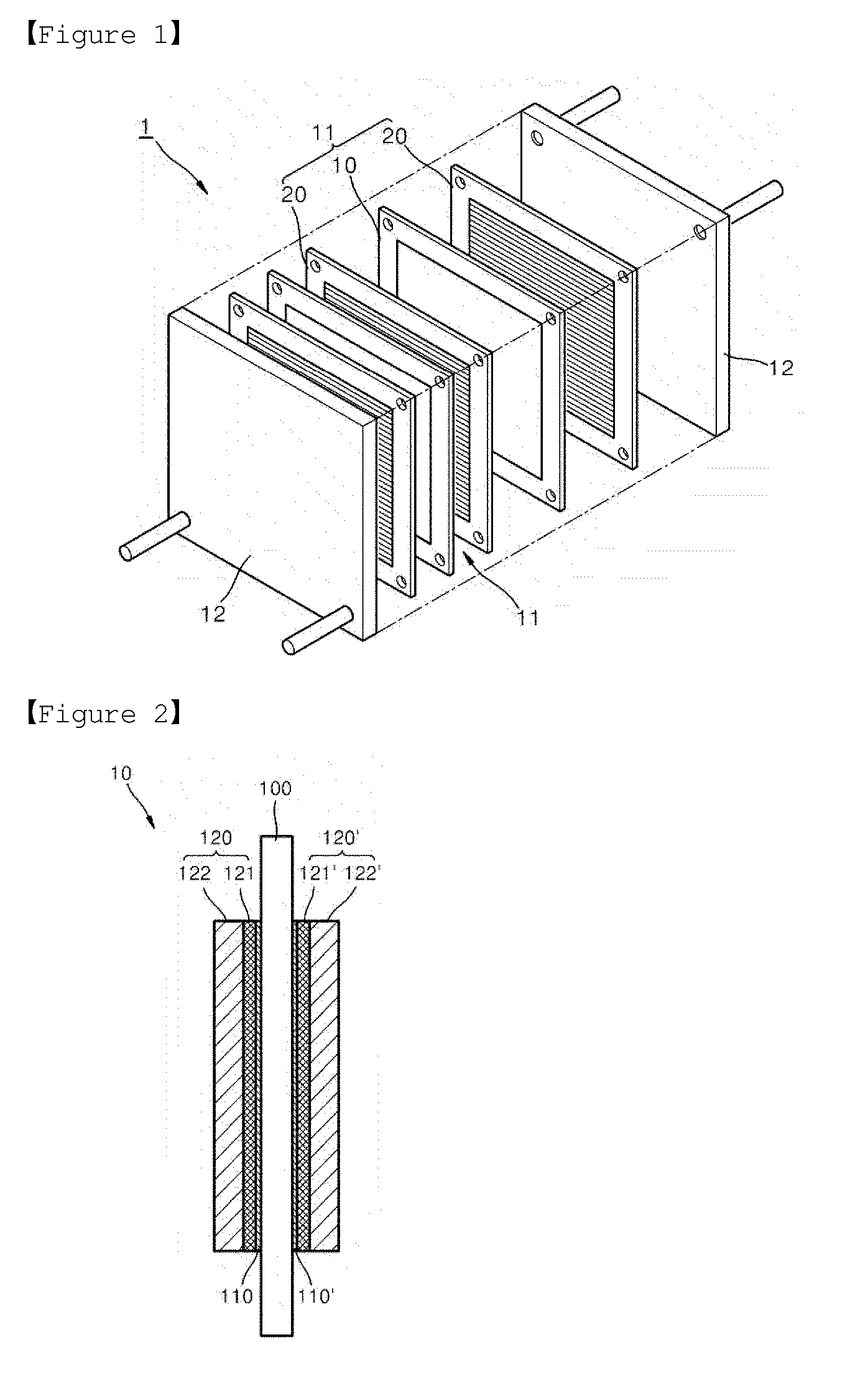Fuel cell and method for manufacturing same
a fuel cell and manufacturing method technology, applied in the direction of fuel cells, fuel cells, solid electrolyte fuel cells, etc., can solve the problems affecting the cost of fuel cells, and achieve excellent oxygen reduction activity, excellent durability, and excellent activity.
- Summary
- Abstract
- Description
- Claims
- Application Information
AI Technical Summary
Benefits of technology
Problems solved by technology
Method used
Image
Examples
example 1
Preparation of Electrode Catalyst
[0165]0.1 mmol of Ni(NO3)2, 0.3 mmol of K2PtCl4, 1.5 mmol of trisodium citrate as a stabilizing agent, 3.2 mmol of lithium dodecyl sulfate (LiDS) as a surfactant were added to and dissolved in 260 ml of water to form a solution, and the result was stirred for 30 minutes. Herein, Ni(NO3)2 and K2PtCl4 had a molar ratio of 3:1, and a measured concentration of the LiDS was approximately twice a critical micelle concentration (CMC) for water.
[0166]Continuously, 1.1 mmol of NaBH4, a reducing agent, was added to the solution, and the result was reacted for 2 hours. The synthesized PtNi hollow metal nanoparticle dispersion liquid was added dropwise to a carbon dispersion liquid. The result was stirred for 15 hours and washed 5 times with water to prepare an electrode catalyst.
[0167]The Pt content of the electrode catalyst prepared according to Example 1 was 24.4 wt %, and the Ni content was 1.6 wt %.
[0168]FIG. 3 and FIG. 4 are transmission electron microscop...
example 2
Measurement on Activity of Electrode Catalyst
[0169]2 mg of the electrode catalyst prepared in Example 1, 1.6 ml of ethanol, 0.4 ml of distilled water, and 20 μl of a 5 wt % nafion solution were mixed to prepare a catalyst ink. The catalyst ink was ultrasonicated for 2 hours and dispersed to prepare a catalyst dispersion liquid.
[0170]On a glassy carbon rotating disk electrode (RDE) having a diameter of 5 mm, which is a working electrode, 16 μl of the catalyst dispersion liquid was applied, and the result was dried to form a catalyst layer. In this case, the amount of the catalyst formed on the working electrode was 15 μg.
[0171]Furthermore, using a 0.1 M HClO4 solution as an electrolyte liquid, an ORR activity test was carried out after cleaning the electrode surface by repeating cyclic voltammetry 15 times at a rate of 50 mV / s in a 0 V to 1.2 V range based on a normal hydrogen electrode (NHE). Herein, the used potentiostat was a Versa STAT MC model of Princeton Applied Research (PAR)...
example 3
Measurement on Durability of Electrode Catalyst
[0177]The same working electrode and catalyst layer as in Example 2 were used. Furthermore, using a 0.1 M HClO4 solution as an electrolyte liquid, a hydrogen adsorption peak area was measured after repeating cyclic voltammetry 1,000 times at a rate of 50 mV / s in a 0 V to 1.2 V range based on a normal hydrogen electrode (NHE). An electrochemical surface area (ECSA) of Pt was calculated from the hydrogen adsorption peak area using the equation shown below.
ECSA[mPt2 / gPt]=Charge[QH,Ccmgeo2]2.1[CmPt2]×catalystweight[gPtcmgeo2]
[0178]QH is a hydrogen adsorption peak area.
[0179]The following Table 2 lists the ECSA of the electrode catalyst according to Example 3.
TABLE 2ECSA after Repeating CVInitial ECSA1,000 TimesECSA19.0915.43(m2 / g Pt)
[0180]FIG. 6 shows a result of measuring durability of the electrode catalyst according to Example 3. Specifically, FIG. 6 shows a result of repeating cyclic voltammetry (CV) 1,000 times on the electrode catalys...
PUM
| Property | Measurement | Unit |
|---|---|---|
| particle diameter | aaaaa | aaaaa |
| thickness | aaaaa | aaaaa |
| particle diameter | aaaaa | aaaaa |
Abstract
Description
Claims
Application Information
 Login to View More
Login to View More - R&D
- Intellectual Property
- Life Sciences
- Materials
- Tech Scout
- Unparalleled Data Quality
- Higher Quality Content
- 60% Fewer Hallucinations
Browse by: Latest US Patents, China's latest patents, Technical Efficacy Thesaurus, Application Domain, Technology Topic, Popular Technical Reports.
© 2025 PatSnap. All rights reserved.Legal|Privacy policy|Modern Slavery Act Transparency Statement|Sitemap|About US| Contact US: help@patsnap.com



